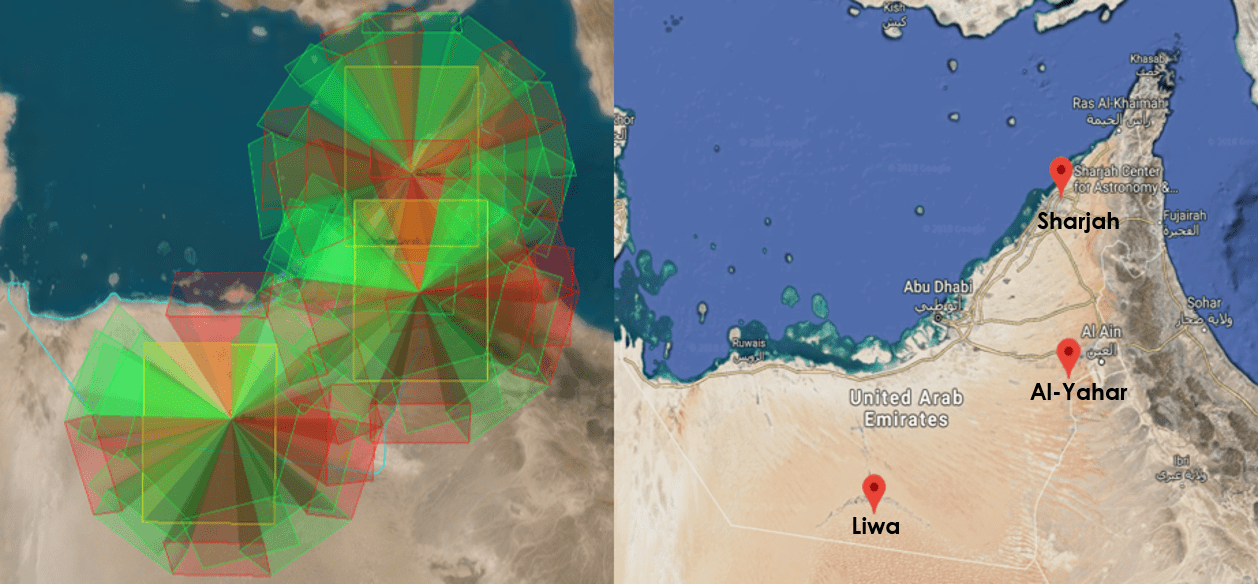Authors: Dr. Ilias Fernini(1), Aisha Alowais(2), Mohammed Talafha(2), Maryam Sharif(2), Yousef Eisa(2), Masa Alnaser(2), Shahab Mohammad(2), Akhmad Hassan(2), Issam Abujami(2), Ridwan Fernini(2) and Salma Subhi(2)
(1) Deputy Director of the Research Laboratories and Observatory at SAASST and Associate Professor at the Applied Physics & Astronomy Department at the University of Sharjah, United Arab Emirates
(2) Sharjah Academy for Astronomy, Space Sciences and Technology, United Arab Emirates
An introduction of the United Arab Emirates Meteor Monitoring Network (UAEMMN) and its equipment is presented.
1 Introduction
Monitoring meteors is an activity that has been practiced ever since human beings lived on planet Earth. Only those who dared to look up at the sky and contemplate them noticed the flashing meteors and questioned them for so long until science solved the mystery. Meteors were previously observed only by naked eyes, until the 1940s when radar meteor observations became possible and huge investments in meteor cameras were made to study the risks of collisions with meteoroids for space exploration. Today, hundreds of meteor monitoring stations are up and running in different parts of the world. In the Gulf region, meteor observations have been done on a small scale by the United Arab Emirates Astronomical Camera Network for the study of meteor showers since Sept. 2016 (e.g., Jenniskens & Odeh, 2017; Jenniskens et al., 2018; 2019).
By considering both the danger and the value of a meteorite when it lands on the Earth surface, the Sharjah Academy for Astronomy, Space Sciences, and Technology established the United Arab Emirates Meteor Monitoring Network (UAEMMN). The network is funded by the UAE Space Agency, and it started operating with only one camera station in September 2018.
2 UAEMMN camera stations’ locations
To ensure having the right observing conditions, a clear sky site must be selected. The first camera station was built at the academy for one main reason: to have a nearby camera station for easy access and perform initial tests before installing the remaining camera stations in remote locations. The first, second, and third camera station were installed at Sharjah (φ = 25.235611° N, λ = 55.539645° E), Al-Ain (φ = 24.285922° N, λ = 55.463625° E), and Liwa (φ = 23.104722° N, λ = 53.754828° E), respectively. The location of the last two camera stations was provided by the National Centre for Meteorology and Seismology (NCMS). Furthermore, the selected sites were based on an STK simulation to maximize the coverage of the UAE sky (Figure 1).

Figure 1 – UAEMMN camera stations’ locations (left) based on STK simulation (right).
3 The camera stations
Seventeen cameras of different lens types (2 mm, 6 mm, and 8 mm) were mounted at the top of each camera mounting. The 6 mm and 8 mm lenses are used to observe distant meteors and fireballs, while the 2 mm is placed at the center of the camera orientation ring to have an all-sky full-view (360 degrees) of the sky. This combination of lenses provides a convenient and sufficient sky coverage as the 8 mm lens covers an area of 884 square degrees of the sky, and the 6 mm covers 1523 square degrees as shown in Figure 2. Figure 3 illustrates the camera orientation, a critical element which distinguishes the UAEMMN from other meteor monitoring stations. From September 2018 until September 2019, the UAEMMN camera stations were able to detect more than 12000 meteors. Figure 4 shows a bright meteor captured on the 20th of September 2019 by the Liwa camera station at 4:59 a.m. (local time) or 0h59m UTC.

Figure 2 – Red squares represent 6 mm sky coverage, while the blue ones represent the 8 mm sky coverage.

Figure 3 – Camera orientation.

Figure 4 – A bright meteor captured by the Liwa camera station on the 20th of September 2019.
References
Jenniskens P., Odeh M. (2017). “Alpha Monocerotids 2017”. CBET, 4457. D. W. E. Green (ed.), IAU Central Bureau Electronic Telegrams.
Jenniskens P., Baggaley J., Crumpton I., Aldous P., Pokorny P., Janches D., Gural P. S., Samuels D., Albers J., Howell A., Johannink C., Breukers M., Odeh M., Moskovitz N., Collison J., Ganju S. (2018). “A survey of southern hemisphere meteor showers”. Planetary & Space Science, 154, 21–29.
Jenniskens P., Lyytinen E., Johannink C., Odeh, M. (2019). “Outburst of 15-Bootids meteor shower”. CBET, 4624. D. W. E. Green (ed.), Central Bureau for Astronomical Telegrams.


